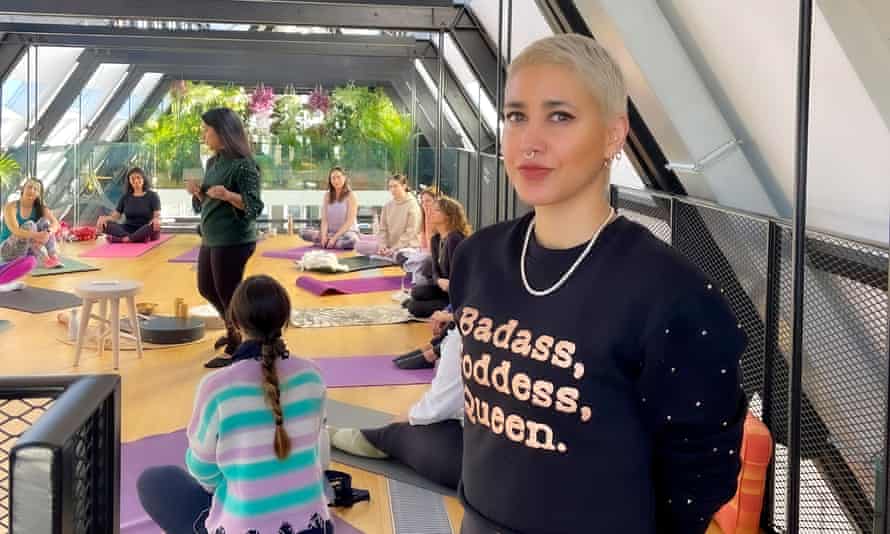
The problem, it turns out, when writing a story about manifesting – the noughties new-age trend now making a pandemic-inspired Gen Z comeback – is that everyone you meet will proclaim they’ve manifested you. It’s a feature, I suppose, rather than a bug: when you believe that desires can be made real by concentration alone, as those in the manifesting game do, and when that desire is for a journalist to cover the manifesting company you recently set up, then, well, who I am to say that they didn’t?
The practice of manifesting is hardly new – it dates back to both the New Thought movement of the 19th century and, more recently, a resurgence in the noughties thanks to the 2006 self-help book The Secret, which sold 30m copies, and Oprah Winfrey, who is a fan.
Yet the latest surge was down to millennials and Gen Z: in 2020, as lockdowns began, Google searches of “manifesting” went up 600%. On Instagram, the hashtags #manifest and #manifestation now total 15m posts. On TikTok, views of manifestation content are currently surging past 9bn. Teen vloggers suddenly became online celebrities by giving manifestation advice. Cara Delevingne said she was manifesting a baby. “Shut up, I’m manifesting” became a meme.
But manifesting, it turned out, was far from just a teen, or online, phenomenon. As lockdowns eased, real-life courses and retreats started to spring up offering to teach it and promising in return, well, everything. There were courses for “Manifesting Creativity” and “Manifesting Happiness”. You could “Manifest Your Financial Freedom” and “Manifest Your Dream Partner”. There were events for those having issues with manifesting (“Why does the Law of Attraction not work for me?”) and events for those who required a manifesting leg-up (“Manifesting with the Moon”).
Eventually, I settled on an event called Manifest 2022, which seemed both unthreatening and all-encompassing. I met its founder, Moon Onyx Starr, 38, for coffee in Mayfair, central London, around the corner from where she lived. Starr wore close-cropped, bleached hair and spoke with the unblinking sincerity of someone who always carries crystals that promote success.
Before the pandemic, Starr worked for a jewellery brand, but was furloughed in March 2020. Like so many others, she felt “displaced, lost and confused”; deep-rooted issues she’d been ignoring came to the surface. At one point, she says, she was on the verge of a breakdown. She threw herself into self-help books and podcasts, and it wasn’t long before she started reading about manifesting.
The concept, roughly, is this: manifesting takes the idea of a positive mental attitude and runs with it. So, while negative thoughts create “limiting beliefs”, and in turn prevent positive things from happening, positive thoughts – when focused on specific goals and outcomes – can make those things happen. “You are co-creating with the universe,” explains Starr, who says she avoids reading the news in order to minimise limiting vibes.
One key caveat: “You can only manifest in line with your higher purpose.” (Essentially, the universe can say no, which is often the explanation when things don’t happen.)
Starr set up her wellness retreat company, Over The Moon Retreats, last spring, and soon discovered events that focused solely on manifesting sold out almost instantly. “I totally manifested the retreat,” she says, of the Hammersmith venue she settled upon. “The facilitators were manifested… you were manifested…”
I start to laugh.
“No,” Starr says, “I’m not joking.”
A few days later, on a crisp Saturday, I found myself origamied on a yoga mat in Hammersmith, surrounded by 20 or so other Manifest 2022 attendees. These weren’t the Gen Zers making manifesting go viral on TikTok. Rather, they were mostly millennials, and nearly all women. Starr welcomed us all to the day, saying, “Whatever you wish to manifest, be it love, money, success, prosperity, spiritual development, it’s coming your way, it’s your time, you’re ready to level up your life.”
We were invited to each tell the rest of the group why we were there, and what we wanted to manifest. Some spoke for 15 minutes or so, detailing life stories defined by trauma; others barely spoke a sentence (“I want to manifest being more confident,” said one, simply). They talked of abortions, abusive childhoods, addictions, depression, panic attacks, cancer.
But what came up again and again was the pandemic. Many felt stuck in one way or another. People had moved country, changed jobs, had quarter-life crises. Many of those in attendance, it turned out, had split up with partners since the pandemic began. Nearly everyone wanted to manifest either self-love or “abundance”, a catch-all manifesting term that can mean more of anything, but often money. Nearly everyone felt lost.
It’s hardly the first time people have sought answers in faith following trauma. After the First World War, for instance, there was a sharp rise in spiritualism: after so much death, people found comfort in the thought that death itself wasn’t the end. Sir Arthur Conan Doyle was a noted proponent. Mediums became such a menace that the authorities were forced to use antiquated Witchcraft and Vagrancy Acts in order to target them. Recent studies have suggested positive thinking can in fact lead to improved mental and physical health. Naturally, commercialisation followed.
Now, Silicon Valley tapped into millennial ennui – or, depending on your amount of cynicism, self-obsession – by taking astrology into the app age. Subscriptions services, such as Sanctuary, boomed by billing themselves as an “Uber for astrological readings” and offering regular personal consultations. “Big Zodiac” is said to currently be worth upwards of $2bn. All promise a future far brighter than the present. But it’s only manifesting that also requires you to put on happy face.
“I think that’s something that’s really been pushed on us and celebrated throughout history,” says Dr Whitney Goodman, a psychotherapist and author of the bestselling book Toxic Positivity, which looks at the dangers inherent in banishing rather than embracing our negative thoughts, when I later speak to her on the phone. “And I saw a lot of it early on in the pandemic. But while there’s value in identifying our goals, the next step, or just using our thoughts to put something out into the world… It can cause people to think there’s something wrong with them, like they’re not doing the right thing.”
At its heart, manifesting is religion without the altruism. Traditional prayer is all well and good when you’re wishing for the wellbeing of others, but it’s slightly frowned upon to get God on the case when you simply want a new partner or a Porsche. Most manifesting sessions, I noted, end with our palms pressed together in a prayer-like pose, though it’s “the universe” we’re told to give thanks to.
Before lunch, we did an exercise involving imaginary chairs. The idea was to look both at the thing we want to manifest and at ourselves from an outsider’s perspective, in case we had any “limiting beliefs” we weren’t aware of. Most intriguing, though, was the teacher, who is a part-time manifesting guru and also a doctor. I caught up with her over vegan salads.
Before the pandemic she was always working or travelling. When it struck, she was single, “and I had nothing but time on my hands… I started to get curious, who am I really?” She found her way to the works of manifesting expert Gabby Bernstein, and was sure the techniques were working, she tells me, after she completed a six-day audiobook course and found herself the very next day bumping into the man who would become her boyfriend.
“And I thought, I’m healed! There he is, I found him! He was my gift from the universe!”
Are they still together?
“We’re not, no. But we’re very good friends.”
Part of manifestation, I was learning, essentially involved looking on the extreme bright side of everything. After all, once you believe events are the direct result of your manifestations, then the logic follows that even negative consequences must be the result of them, too – and therefore must actually be positive. You give yourself over to fate, but a kindly one of your own making. For the doctor, the boyfriend “gave me what I needed to learn next”.
At her day-job, she says, she often combines manifestation advice with traditional medical treatment, even if she admits it’s somewhat frowned upon. Just the other day, she had a cancer patient who wasn’t responding to the various treatments they had been trying.
“I said: ‘I know I can be sued afterwards for asking this, as it is a very unorthodox question, you may want to get a different doctor afterwards, but I’m going to invite you to close your eyes and…’”
She discovered the woman’s mother had died of the same disease and so uncovered a “limiting belief” she felt was holding her back. “And when she opened her eyes her energy was completely different.”
Has the patient responded better to treatment? “I hope so,” she says, “we’re going to scan her and see.”
The business of manifesting is tough to quantify. But it’s clearly the growth subsection of a wellness market now said to be worth a staggering $1.5tr. On sale at Manifest 2022 were a variety of manifestation crystals, a variety of manifestation crystals set in jewellery, and some plain old manifestation jewellery.
I was intrigued by the latter and got talking to Natalie Benmayor, founder of wellness jewellery label Capsule Eleven. Benmayor launched her brand in the pandemic. She’d started seeing the numbers 11-11 everywhere (“Like, every time I’d look at my phone”), and realised they had special significance for manifesting. She had the idea for a company selling high-end “spiritual” jewellery items, which, she says, she subsequently manifested.
Capsule Eleven’s website boasts a range of items that either ward off or attract something, but it’s the manifesting 11:11 Pendant (£120) that remains by far her bestseller.
“And I swear to God it works, as I got the brand off the ground so quickly,” she says. “The amount of people I’ve connected to through this necklace is crazy.” She counts the musician Grimes as her most high-profile customer. Yet Benmayor was attending in a personal rather than professional capacity. Like many, she had been furloughed. She’d been through every type of therapy – hypnotherapy, life alignment, reiki, crystal healing, you name it – but still felt stuck. “I’m here to manifest abundance in business,” she says. “And also love.”
We ended the day with the main event, a manifestation session led by Roxy Marrone, a 23-year-old from west London whose mother is a shaman, and who spoke in gently lilting questions.
Marrone also set up her manifestation company in the pandemic. It began when she started hosting manifestation rituals for friends at her family home in lockdown, and she quickly realised it was giving them all something they desperately needed. Perhaps more than any other age group, Gen Z suddenly felt their fate was not their own. Manifesting became a way to take back control.
“People did need it, they felt hopeless,” she says of the sessions she hosted, noting that many people started crying. “It was amazing how vulnerable they could be.” Last May, her company, House of Roxy, started selling do-it-yourself manifestation kits and Marrone began hosting professional sessions once lockdown ended.
“For me, my business is not about making money; everything I do is to benefit someone in some way,” she says. “I’m not here to sell you shit. I’m here to sell you something that will change your life.” I later check on the website: a Full Moon Manifestation kit costs £85, while a Manifestation Ring (“The power of this ring will help you manifest love and self-love”) will set you back £2,300.
Like most things that go viral, however, Gen Z manifesting has taken on some curious quirks. On YouTube, teen manifesters teach things like the “3-6-9” and “7-7-7” method (this nearly always involves writing a boy’s name down many times a day in order to make him text you). On Instagram, they’ve taken to crowdsourcing – remarkably specific posts circulate saying things like, “A huge check of $118,811 is about to land in your hand tomorrow! Type YES to Affirm”, under which hundreds of people write “YES” followed by their choice of emojis (I contact a few users to check in: nothing yet). On TikTok, teens have started sharing particular sounds – they promise that listening to them every day helps manifestation (“I used this sound for one week and just got the cat I’ve been asking for”), while others warn skipping the sound can drastically hinder it (“I skipped the sound and my dad died”).
The latter may sound silly, but it’s indicative of where a belief in manifesting can easily end up: that everything bad that happens is also your fault. You just didn’t manifest your life well enough. It’s something Dr Goodman sees more and more with her patients.
“I think particularly for people who have been abused, who have lived in poverty, who have dealt with real traumatic hardship, it can feed into and deepen this belief of, like, I am the reason that bad things happen to me,” she says. “They really believe these things in their life were caused by their beliefs.”
Marrone, meanwhile, says she is forever getting Instagram DMs from young people asking how they can manifest their goals: “It’s crazy, like, 13-year-olds DM me, asking, like, how do I manifest? How do I use crystals?”
Doesn’t Marrone worry that, especially among young people, this can also be unhealthy?
“On any social media there’s always an unhealthy side,” she allows, “but this is not an unhealthy thing to promote.”
As we start our session, we begin with one part of manifesting that doesn’t get the headlines, but which I can’t help but feel would have been healthy in the pandemic regardless of your beliefs. Before we began, we were told we needed to “raise our vibrations”, which sounds complicated, but the reality was sweetly humble.
We were asked to think of the small things we were grateful for and to think about those things every day. We closed our eyes, we concentrated. Marrone asked us to make sure our feet were touching the floor; she told us she often gives thanks to her breakfast: “It honestly makes me so happy.”
She mentioned that things can’t be achieved with manifesting alone – we had to meet the universe halfway (“You have to put the work in”). She told us to write down three things we wanted to manifest by the end of the year and she told us to close our eyes again and think about each in as much detail as possible. (“I don’t want any ‘happiness’”, she said, “If you want your dream house, I want to know what the carpet is like.”)
The key thing, she said, was to focus on the emotion it would bring: how would having that house make us feel? I concentrated. I felt. We breathed in through our noses, out through our mouths. I have to admit: it felt good. It didn’t last. But briefly, it felt good.
I wondered if Marrone ever sets limits: what if a teen wanted to manifest a mansion by the end of the year?
“Basically, everyone is capable of everything,” she said matter-of-factly, “but if you don’t believe what you’re saying, you’re blocking it with negative thoughts. It starts with self-worth.”
What if they wanted to be the first astronaut on Mars?
“I would say, think of a manifestation that is realistic for you to achieve by the end of the year, but not something that you’re afraid that you won’t achieve.”
Finally, I ask what some of her own recent manifestations have been. Setting up her company, she said, for one. Growing her Instagram followers. “And I’ve manifested an article written about me in Harper’s Bazaar,” she said.
I was more than welcome, she said, “to do a solo piece” on her if I wanted to. I can almost feel her manifesting it now.



